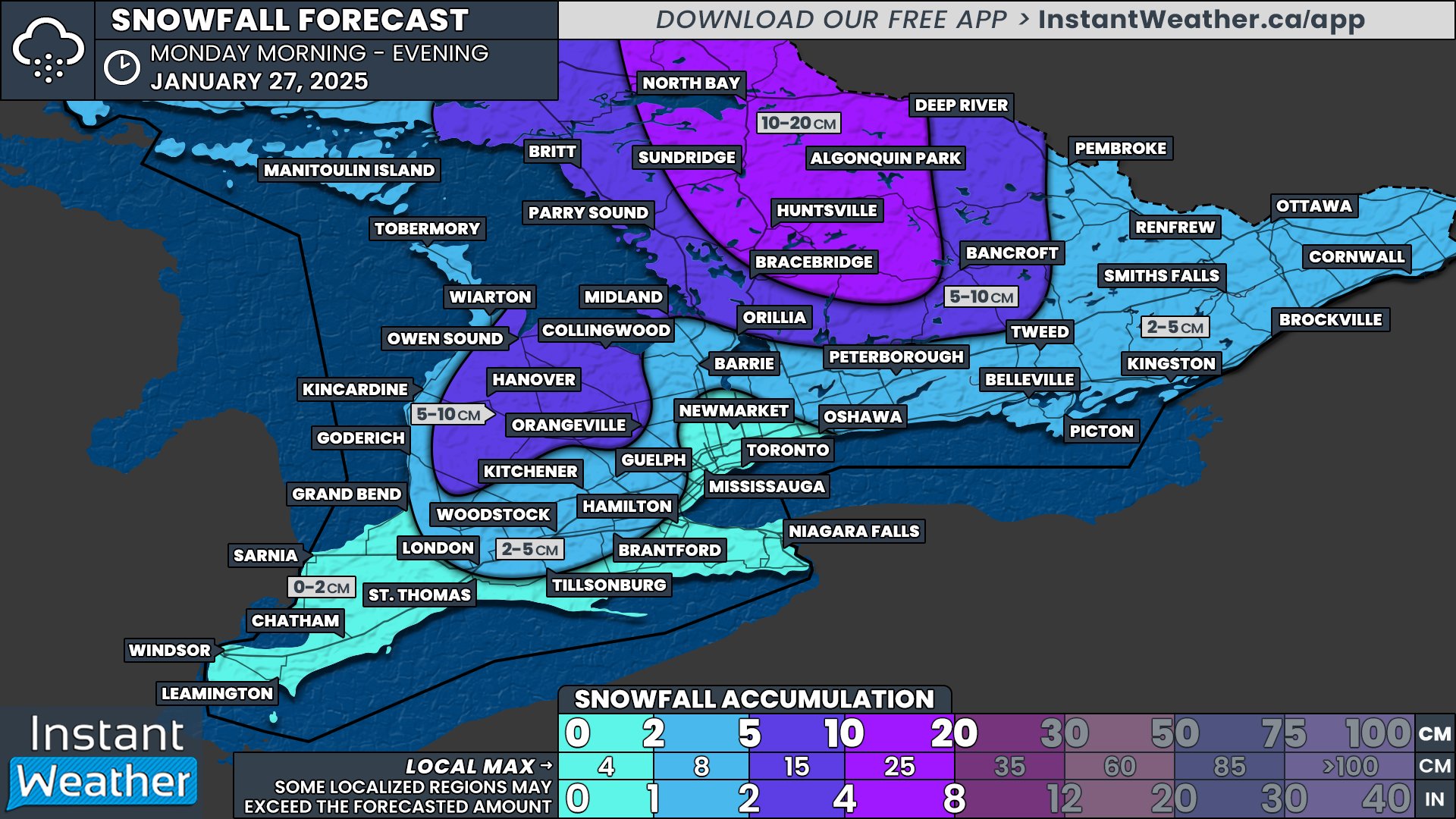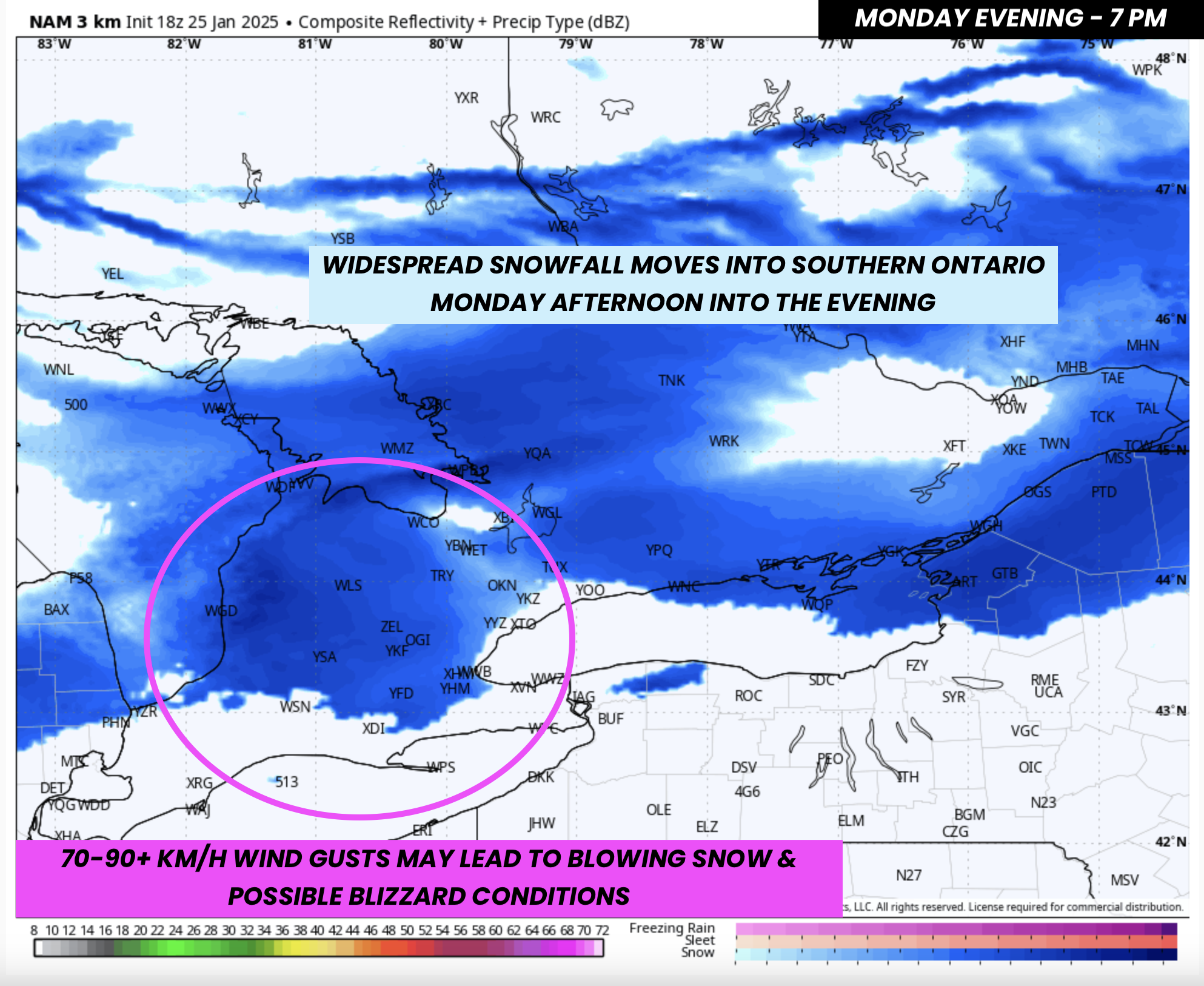Intense Snowstorm Could Bring Blizzard Conditions and Up to 30-60cm of Snow to Southern Ontario This Weekend
/The snowy weather isn’t letting up as yet another winter storm takes aim at Southern Ontario over the Family Day long weekend. This system will arrive in multiple waves, beginning Saturday and continuing through Sunday. By the time it moves out late Sunday, much of Southern Ontario could be buried under as much as 60 cm of snow.
Strong winds will develop throughout Sunday morning into the afternoon, with gusts reaching 50 to 80 km/h in some areas. These powerful winds, combined with heavy snowfall, will create dangerous whiteout conditions and may even reach blizzard criteria. Travel is expected to become difficult as early as Saturday morning, with conditions steadily worsening through the night and into Sunday.
The most hazardous conditions are expected Sunday morning and afternoon, as intense snowfall rates are combined with strong wind gusts, making all non-essential travel extremely dangerous. Highway closures are highly likely in the hardest-hit regions as plows struggle to keep up with rapid snowfall rates, while blowing and drifting snow significantly reduces visibility.
There is still some uncertainty regarding the storm's exact track, which will determine where the heaviest snowfall occurs. Areas along the Lake Erie shoreline and possibly parts of the Golden Horseshoe could see periods of freezing rain or ice pellets by late Sunday morning. While this would create its own hazards, any mixing would also lower overall snowfall totals.
As of now, Eastern and parts of Central Ontario appear to be in line for the highest snowfall amounts. Combined two-day snowfall totals could range from 30 to 60 cm by Sunday night, with 5-10 cm expected on Saturday and an additional 25-50 cm possible on Sunday.
HOURLY SNOWFALL RATE/intensity - MAP FROM WEATHERBELL
The storm will get underway Saturday morning as steady snow moves into Deep Southwestern Ontario from Michigan. It will spread into London and the Greater Toronto Area (GTA) by late morning. Some light flurries may reach Central and Eastern Ontario, but the more persistent snowfall will remain south of Lake Simcoe.
At this stage, conditions may not seem too severe, leading to the false impression that the storm has been overhyped. However, don’t be fooled—snowfall rates will gradually increase through the afternoon, reaching 1-2 cm per hour and steadily accumulating.
PRECIPITATION TYPE - MAP FROM WEATHERBELL
By mid-afternoon Saturday, light to moderate snowfall will have spread across most of Southern Ontario. The heaviest snowfall will be concentrated over Southwestern Ontario and the GTA, while Central and Eastern Ontario, including the Ottawa Valley, may only see scattered flurries.
There are indications that parts of Deep Southwestern Ontario—including Windsor, Chatham, and possibly London—may see a transition to ice pellets or freezing rain. Meanwhile, Kitchener, Hamilton, and the GTA should remain primarily snow.
HOURLY SNOWFALL RATE/intensity - MAP FROM WEATHERBELL
Heading into the evening, the storm’s moisture supply will intensify as it taps into the Gulf of Mexico, keeping snow steady across Southern Ontario. However, Central and Eastern Ontario may experience more scattered snowfall during this time. The most persistent snow bands are expected to set up along the Windsor-London-Hamilton corridor.
Some mixing could still occur near the Lake Erie shoreline, particularly in Leamington and the southern Niagara region, though it remains uncertain how far inland it may extend. If the mixing line pushes north, areas such as Windsor could also see freezing rain.
By the end of Saturday, snowfall totals are expected to range from 5 to 10 cm across much of Southern Ontario, with locally higher amounts of up to 15 cm in areas benefiting from lake enhancement like Southwestern Ontario and the Golden Horseshoe.
Eastern Ontario and the Ottawa Valley will see lower totals, between 2 and 5 cm, as the first wave of snow stays focused farther south.
PRECIPITATION TYPE - MAP FROM WEATHERBELL
Conditions will deteriorate rapidly overnight Saturday as even more moisture-laden precipitation moves in from Michigan. Snowfall rates will increase during the pre-dawn hours, starting in the southwest around midnight before progressing east and north through the morning.
There remains some disagreement among forecast models regarding the extent of mixing along the Lake Erie shoreline, but there is a possibility of significant ice accretion in parts of Windsor and the Niagara region.
HOURLY SNOWFALL RATE/intensity - MAP FROM WEATHERBELL
By late Sunday morning, the system is expected to intensify rapidly as the low-pressure center tracks south of the Great Lakes. This intensification will result in significantly higher snowfall rates, especially in the GTA, Niagara region, and Central Ontario, including Barrie, Muskoka, and Peterborough.
Snowfall rates could reach 5-10 cm per hour, making it impossible for road crews to keep up. Eastern Ontario and the Ottawa Valley will see steady snow increase throughout Sunday afternoon and into the early evening.
ESTIMATED WIND GUSTS - MAP FROM WEATHERBELL
Adding to the severity of the storm, strong wind gusts of 50-80 km/h will develop through Sunday morning, with the highest gusts expected in Central and Eastern Ontario. These winds, combined with intense snowfall rates, will almost certainly lead to blizzard conditions in some areas.
Visibility will be near zero, with blowing and drifting snow making travel dangerous. All non-essential travel should be avoided on Sunday morning and afternoon, as highway closures are likely in the hardest-hit regions. With snow falling at rates of 5-10 cm per hour, it will be extremely easy to become stranded, as plows will struggle to keep roads passable.
PRECIPITATION TYPE - MAP FROM WEATHERBELL
Despite being less than 48 hours away, there is still some uncertainty in the storm's track and timing. Different forecast models continue to show varying scenarios, which could impact snowfall totals and the extent of mixing.
The short-range American model (HRRR), which provides detailed hourly forecasts, aligns closely with the Canadian and European models. These models suggest a more southern track, keeping the GTA and much of Southern Ontario primarily in the snow zone.
However, another American model (NAM) suggests a more northern track with a later arrival. If this scenario plays out, the mixing line would shift farther north, bringing ice pellets or freezing rain from London to Hamilton and into the GTA. This would reduce snowfall totals in these areas but create hazardous icy conditions.
This model also suggests the mixing could extend along the Lake Ontario shoreline into parts of Southeastern Ontario, including Belleville, Kingston, and Brockville. While this scenario is less likely, it’s still worth monitoring.
Additionally, the NAM model points to a significant icing event for Hamilton and the Niagara region, with potential ice accretion of 10-15 mm. If this happens, localized power outages and tree damage could occur.
The model also suggests that while some forecasts indicate the heaviest snow will arrive early Sunday, this scenario shifts the worst conditions to the afternoon in Southwestern Ontario and the GTA, extending into the evening for Eastern Ontario.
Regardless of the final track, conditions should improve as snow tapers off from west to east late Sunday evening, with lingering snow in Eastern Ontario into early Monday morning. However, lake-effect snow could quickly develop around Lake Huron and Georgian Bay as the system exits.
By the time this storm is over, a wide swath of Eastern and Central Ontario could see 30-60 cm of fresh snow, including the accumulation from both Saturday and Sunday.
For Southwestern Ontario and the GTA—including Sarnia, London, Kitchener, Hamilton, and Toronto—snowfall totals will likely range from 20-40 cm. However, if mixing occurs on Sunday, snowfall amounts could drop to 15-30 cm or even lower, depending on how extensive the ice pellets or freezing rain become.
The lowest snowfall totals will likely be in Deep Southwestern Ontario and along the Lake Erie shoreline, where freezing rain and ice pellets will reduce overall accumulation. Areas such as Windsor, Leamington, Chatham, St. Thomas, and Niagara Falls could see between 15-30 cm of snow, depending on how much mixing occurs.
We are closely monitoring the latest forecast data and will provide a more detailed breakdown of Sunday’s snowfall totals in an updated forecast on Saturday. Stay tuned for further updates.


























































































